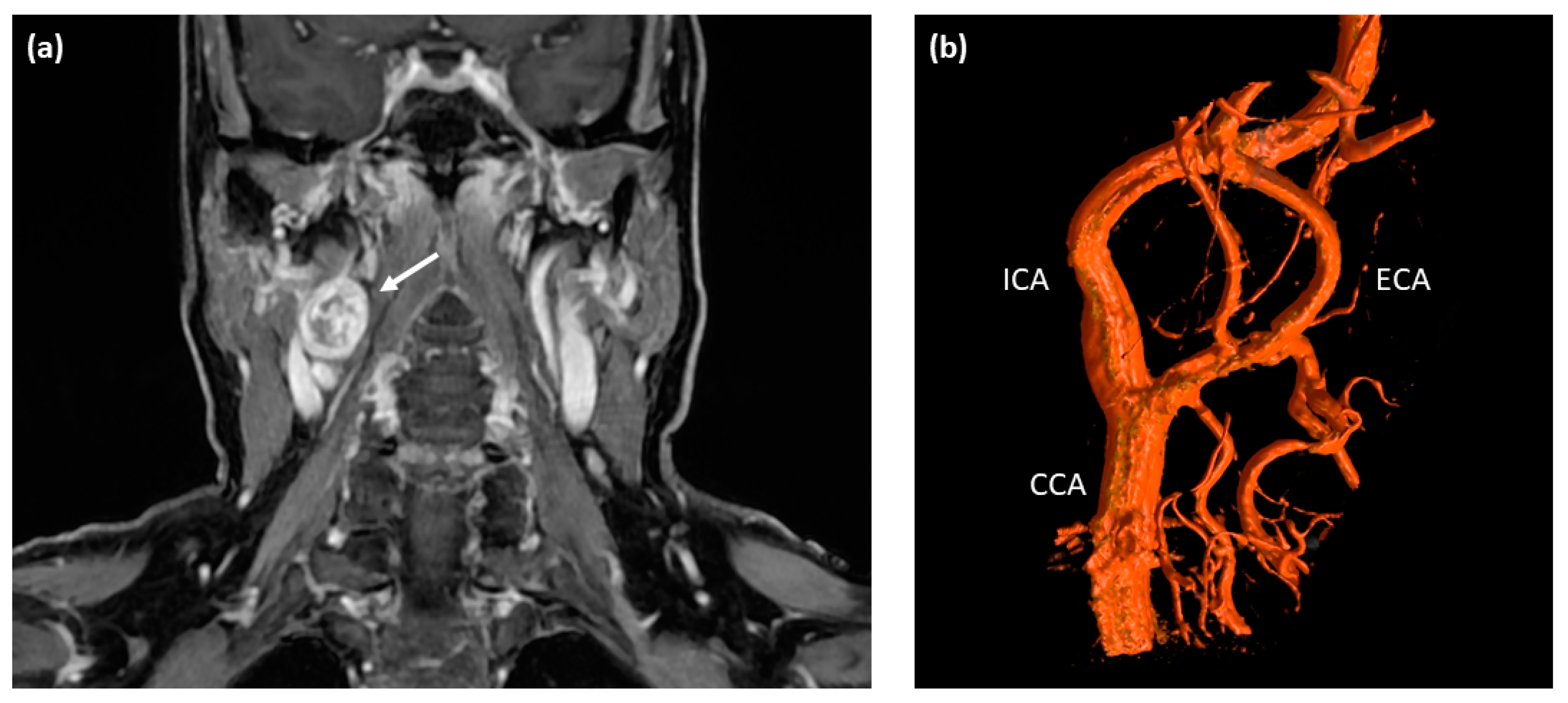Schwannoma of the Hypoglossal Nerve Mimicking Carotid Body Paraganglioma
Abstract
:1. Introduction
2. Case Presentation
3. Discussion
Author Contributions
Funding
Institutional Review Board Statement
Informed Consent Statement
Data Availability Statement
Conflicts of Interest
References
- Amato, B.; Bianco, T.; Compagna, R.; Siano, M.; Esposito, G.; Buffone, G.; Serra, R.; de Franciscis, S. Surgical resection of carotid body paragangliomas: 10 years of experience. Am. J. Surg. 2014, 207, 293–298. [Google Scholar] [CrossRef] [PubMed]
- Bobadilla-Rosado, L.O.; Garcia-Alva, R.; Anaya-Ayala, J.E.; Peralta-Vazquez, C.; Hernandez-Sotelo, K.; Luna, L.; Cuen-Ojeda, C.; Hinojosa, C.A. Surgical Management of Bilateral Carotid Body Tumors. Ann. Vasc. Surg. 2019, 57, 187–193. [Google Scholar] [CrossRef] [PubMed]
- Guha, A.; Musil, Z.; Vicha, A.; Zelinka, T.; Pacak, K.; Astl, J.; Chovanec, M. A systematic review on the genetic analysis of paragangliomas: Primarily focused on head and neck paragangliomas. Neoplasma 2019, 66, 671–680. [Google Scholar] [CrossRef] [PubMed]
- Gonzalez-Urquijo, M.; Castro-Varela, A.; Barrios-Ruiz, A.; Hinojosa-Gonzalez, D.E.; Salas, A.K.G.; Morales, E.A.; González-González, M.; Fabiani, M.A. Current trends in carotid body tumors: Comprehensive review. Head Neck 2022, 1–17. [Google Scholar] [CrossRef] [PubMed]
- Liu, J.; Mu, H.; Zhang, W. Diagnosis and treatment of carotid body tumors. Am. J. Transl. Res. 2021, 13, 14121–14132. [Google Scholar] [PubMed]
- Gao, B.; Luo, Y.; Zhang, M.; Zhou, C.; Huang, B.; Wen, X. The value of ultrasound for the preoperative assessment of carotid body tumors. Clin. Imaging 2022, 87, 38–42. [Google Scholar] [CrossRef] [PubMed]
- Shamblin, W.R.; ReMine, W.H.; Sheps, S.G.; Harrison, E.G., Jr. Carotid body tumor (chemodectoma). Clinicopathologic analysis of ninety cases. Am. J. Surg. 1971, 122, 732–739. [Google Scholar] [CrossRef]
- Gonzalez-Urquijo, M.; Viteri-Pérez, V.H.; Becerril-Gaitan, A.; Hinojosa-Gonzalez, D.; Enríquez-Vega, M.E.; Soto Vaca Guzmán, I.W.; Valda-Ameller, G.E.; de Jesús García-Pérez, J.; Vaquero-Puerta, C.; Jaramillo-Vergara, V.H.; et al. Clinical Characteristics and Surgical Outcomes of Carotid Body Tumors: Data from the Carotid Paraganglioma Cooperative International Registry (CAPACITY) Group. World J. Surg. 2022, 46, 2507–2514. [Google Scholar] [CrossRef] [PubMed]
- Kim, G.Y.; Lawrence, P.F.; Moridzadeh, R.S.; Zimmerman, K.; Munoz, A.; Luna-Ortiz, K.; Oderich, G.S.; de Francisco, J.; Ospina, J.; Huertas, S.; et al. New predictors of complications in carotid body tumor resection. J. Vasc. Surg. 2017, 65, 1673–1679. [Google Scholar] [CrossRef] [PubMed]
- Robertson, V.; Poli, F.; Hobson, B.; Saratzis, A.; Ross Naylor, A. A Systematic Review and Meta-Analysis of the Presentation and Surgical Management of Patients With Carotid Body Tumours. Eur. J. Vasc. Endovasc. Surg. 2019, 57, 477–486. [Google Scholar] [CrossRef] [PubMed] [Green Version]
- Edizer, D.T.; Mercan, H.; Cansiz, H. Hypoglossal schwannoma presenting only with headache. J. Craniofac. Surg. 2010, 21, 261–262. [Google Scholar] [CrossRef] [PubMed]
- Lee, M.K.; Sidell, D.R.; Mendelsohn, A.H.; Blackwell, K.E. Hypoglossal schwannoma masquerading as a carotid body tumor. Case Rep. Otolaryngol. 2012, 2012, 842761. [Google Scholar] [CrossRef] [PubMed]
- Karpati, R.L.; Loevner, L.A.; Cunning, D.M.; Yousem, D.M.; Li, S.; Weber, R.S. Synchronous schwannomas of the hypoglossal nerve and cervical sympathetic chain. AJR Am. J. Roentgenol. 1998, 171, 1505–1507. [Google Scholar] [CrossRef] [PubMed]
- Cavalcanti, D.D.; Martirosyan, N.L.; Verma, K.; Safavi-Abbasi, S.; Porter, R.W.; Theodore, N.; Sonntag, V.K.; Dickman, C.A.; Spetzler, R.F. Surgical management and outcome of schwannomas in the craniocervical region. J. Neurosurg. 2011, 114, 1257–1267. [Google Scholar] [CrossRef] [PubMed]
- Netterville, J.L.; Reilly, K.M.; Robertson, D.; Reiber, M.E.; Armstrong, W.B.; Childs, P. Carotid body tumors: A review of 30 patients with 46 tumors. Laryngoscope 1995, 105, 115–126. [Google Scholar] [CrossRef] [PubMed]
- McCurdy, J.A., Jr.; Hays, L.L.; Johnson, G.K. Parapharyngeal neurilemmoma of the hypoglossal nerve. Laryngoscope 1976, 86, 724–727. [Google Scholar] [CrossRef] [PubMed]
- Plitt, A.; El Ahmadieh, T.Y.; Bindal, S.; Myers, L.; White, J.; Gluf, W. Hypoglossal Schwannoma of Neck: Case Report and Review of Literature. World Neurosurg. 2018, 110, 240–243. [Google Scholar] [CrossRef] [PubMed]
- Bartindale, M.; Heiferman, J.; Joyce, C.; Anderson, D.; Leonetti, J. Facial Schwannoma Management Outcomes: A Systematic Review of the Literature. Otolaryngol. Head Neck Surg. 2020, 163, 293–301. [Google Scholar] [CrossRef] [PubMed]
- Bacciu, A.; Nusier, A.; Lauda, L.; Falcioni, M.; Russo, A.; Sanna, M. Are the current treatment strategies for facial nerve schwannoma appropriate also for complex cases? Audiol. Neurootol. 2013, 18, 184–191. [Google Scholar] [CrossRef] [PubMed]



Publisher’s Note: MDPI stays neutral with regard to jurisdictional claims in published maps and institutional affiliations. |
© 2022 by the authors. Licensee MDPI, Basel, Switzerland. This article is an open access article distributed under the terms and conditions of the Creative Commons Attribution (CC BY) license (https://creativecommons.org/licenses/by/4.0/).
Share and Cite
Linxweiler, M.; Reith, W.; Wagner, M.; Kühn, J.P.; Schick, B. Schwannoma of the Hypoglossal Nerve Mimicking Carotid Body Paraganglioma. Diagnostics 2022, 12, 2122. https://doi.org/10.3390/diagnostics12092122
Linxweiler M, Reith W, Wagner M, Kühn JP, Schick B. Schwannoma of the Hypoglossal Nerve Mimicking Carotid Body Paraganglioma. Diagnostics. 2022; 12(9):2122. https://doi.org/10.3390/diagnostics12092122
Chicago/Turabian StyleLinxweiler, Maximilian, Wolfgang Reith, Mathias Wagner, Jan Philipp Kühn, and Bernhard Schick. 2022. "Schwannoma of the Hypoglossal Nerve Mimicking Carotid Body Paraganglioma" Diagnostics 12, no. 9: 2122. https://doi.org/10.3390/diagnostics12092122
APA StyleLinxweiler, M., Reith, W., Wagner, M., Kühn, J. P., & Schick, B. (2022). Schwannoma of the Hypoglossal Nerve Mimicking Carotid Body Paraganglioma. Diagnostics, 12(9), 2122. https://doi.org/10.3390/diagnostics12092122




